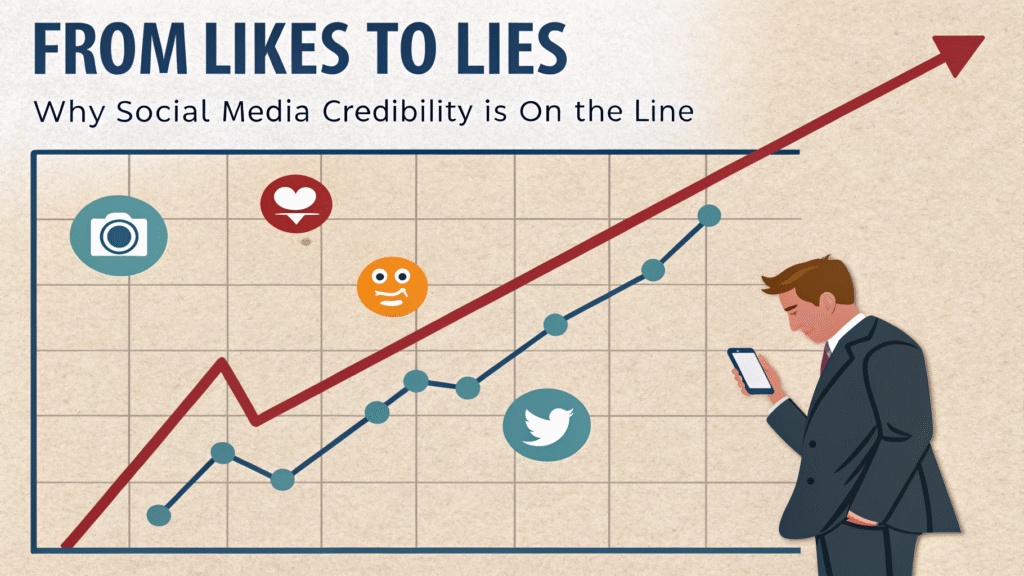
Introduction
The currency of social media was once simple: a “like” was a token of approval, a share a mark of endorsement. But today, that currency has been devalued. We’ve moved from likes to lies, where the relentless pursuit of engagement often overshadows truth. This erosion of social media credibility presents a critical challenge for entrepreneurs, marketers, and content creators who rely on these platforms to build their brands. When audiences don’t know what to believe, every marketing message is met with skepticism. This article examines the forces behind this credibility crisis and provides a roadmap for building authentic trust in a digital landscape saturated with doubt.
History & Evolution: The Journey to a Credibility Crisis
The decline in social media credibility didn’t happen overnight. It was a gradual shift driven by platform economics and user behavior.
- The Age of Innocence (Early 2000s): Platforms were primarily for connecting with real-life friends and family. Content was personal, and credibility was assumed within your immediate network.
- The Incentivization of Engagement (2010s): With the rise of algorithmic feeds, platforms began rewarding content that generated reactions. Virality became the goal, and emotionally charged or sensational content—regardless of its truthfulness—often gained the most traction. This marked the beginning of the shift from likes to lies.
- The Proliferation of Misinformation (2016-Present): The business model of capturing attention reached its logical conclusion: the widespread and rapid dissemination of misinformation and disinformation. Major world events became catalysts, exposing how easily false narratives could flourish.
- The Rise of the “De-influencer”: As a direct response to declining trust, a new trend emerged where creators gain credibility by critiquing products and trends, signaling a consumer demand for honesty over hype.
Alt text: A visual timeline illustrating the historical journey from likes to lies and the resulting social media credibility crisis.
Audience & Demographics: Who Feels the Credibility Gap?
The credibility crisis affects different users in distinct ways, shaping their online behavior and expectations.
- General Users: Many experience “truth decay,” finding it increasingly difficult to distinguish fact from fiction. This leads to anxiety, disengagement, and a tendency to retreat to private, encrypted groups.
- Content Creators: Credible creators face an uphill battle against sensationalist accounts. They must work harder to prove their authenticity and provide verifiable sources to maintain their audience’s trust.
- Marketers and Brands: Marketing campaigns are inherently less effective when launched on distrusted platforms. Brands are now forced to invest heavily in transparent communication and ethical practices to earn consumer belief.
- Entrepreneurs: For startups, building brand credibility from scratch is more challenging than ever. They must leverage every tool available—from customer testimonials to transparent sourcing—to establish trust quickly.
Key Features & Functions: The Mechanics of Distrust
The very architecture of social media platforms often works against the establishment of credibility.
The Algorithm: Engine of the “Lies”
The core features that drive platforms also contribute to the credibility problem:
- Engagement-Based Ranking: Algorithms prioritize content that keeps users on the platform. Unfortunately, lies, outrage, and controversy are frequently more engaging than nuanced, factual information.
- The Filter Bubble Effect: By showing users content that aligns with their existing views, algorithms create echo chambers that reinforce beliefs and shield users from corrective information.
- Velocity Over Verification: The emphasis on real-time posting rewards being first, not being right. There is little algorithmic penalty for sharing inaccurate information quickly.
The User Interface: Designed for Superficiality
- Simplified Metrics: Reducing complex value to a simple count of “likes” or “followers” encourages quantitative growth over qualitative trust-building.
- Ephemeral Content: Features like “Stories” promote off-the-cuff, less polished content, which can feel authentic but also allows misinformation to spread without a permanent record.
Business & Marketing Potential: Finding Opportunity in the Crisis
For agile businesses, the credibility gap creates a significant opportunity to stand out.
- Trust as a Competitive Advantage: In a sea of skepticism, a brand known for its transparency and honesty can build a fiercely loyal customer base. Your credibility becomes your unique selling proposition.
- The Power of Micro-Influencers: Collaborating with micro-influencers who have highly engaged, trusting communities often yields better results than partnering with large-scale influencers whose followers may be more skeptical.
- Content That Educates: Shift from promotional content to educational content that genuinely helps your audience. How-to guides, expert interviews, and data-driven reports build authority and credibility.
- Leveraging User-Generated Content (UGC): Authentic reviews, testimonials, and customer photos serve as social proof, which is often more trusted than brand-generated messages.
Best Practices & Tips for Building Credibility
Here’s how your business can actively combat distrust and build a credible online presence.
- Prioritize Accuracy Over Speed: Take the extra time to verify information before you post. Correct mistakes openly and promptly if they occur.
- Show Your Work: Build trust by being transparent. Share behind-the-scenes glimpses of your process, introduce your team, and explain your business decisions.
- Engage Authentically: Don’t just broadcast. Respond to comments thoughtfully, ask for feedback, and participate in conversations. Show that there are real people behind the brand.
- Diversify Your Platform Presence: Build a foundation on a platform you own, like an email list or a blog. Use social media to drive traffic there, reducing your reliance on algorithmic whims.
- Cite Reliable Sources: When sharing data or news, always link to reputable, original sources. This demonstrates a commitment to accuracy and empowers your audience to learn more.
Challenges & Limitations
Rebuilding social media credibility is fraught with systemic challenges.
- The Misinformation Economy: There is a financial incentive for bad actors to create and spread false content, making it a persistent problem.
- Deepfakes and AI-Generated Content: Advancing technology makes it easier to create convincing fake audio and video, posing a monumental threat to digital trust.
- Scale of Moderation: The volume of content uploaded every minute makes it impossible for platforms to catch every instance of misinformation with perfect accuracy.
- Psychological Biases: Users are naturally predisposed to believe information that confirms their existing beliefs, making them vulnerable to targeted disinformation campaigns.
Future Outlook
The future of social media credibility will be shaped by several evolving trends.
- Demand for Verification: Expect a rise in tools and platform features that help verify the authenticity of content and accounts, such as blue checks for identity verification.
- Decentralized Social Media: Platforms built on blockchain technology (e.g., Mastodon, Bluesky) could shift control to users, potentially creating communities with stronger shared norms of credibility.
- Increased Regulation: Governments will likely introduce stricter laws holding platforms accountable for certain types of harmful content, forcing changes in how they manage information.
- A Shift Towards Private Communities: As public forums become more distrusted, brands will focus on building credibility within smaller, private groups where communication is more direct and personal.

Conclusion
The journey from likes to lies has fundamentally damaged social media credibility. For businesses, this isn’t a peripheral issue; it’s a central strategic challenge. The platforms themselves are grappling with solutions, but the responsibility now falls heavily on users and brands to be agents of truth. By choosing transparency over hype, accuracy over speed, and genuine connection over vanity metrics, entrepreneurs and marketers can not only navigate this crisis but thrive within it. Ultimately, rebuilding trust is the most valuable marketing investment you can make.